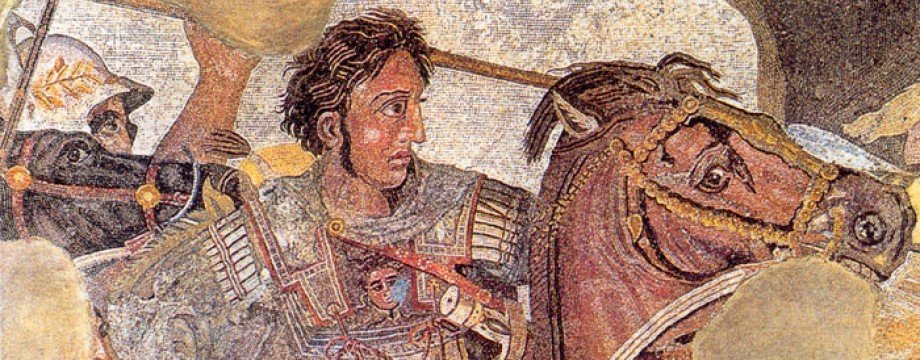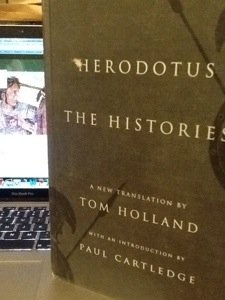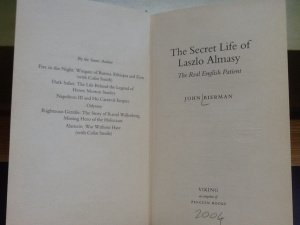
I have just finished reading The Secret Life of Laszlo Almasy by John Bierman. It is an excellent read and I highly recommend it to anyone with an interest in Almásy’s life.
.
Laszlo Ede Almásy is a controversial figure. Depending on who you read, he was pro-Nazi, a Soviet spy, helped saved Jews during the War, a German agent, and British agent. There are not enough documents publicly available to pin him down to one side or another.
.
One thing we can be certain of, though, is that he loved the Western or Libyan Desert (so named even though part of it is in Egypt), and he spent numerous years exploring it. Almásy’s abiding desire - his pothos - was to find the lost oasis of Zerzura and Cambyses’ lost army, which was wiped out by a sandstorm after leaving the Siwah Oasis (Herodotus 3:26). Thank goodness Alexander did not encounter such a menace when he visited it.

Unfortunately, Almásy achieved neither aim (unless Zerzura is to be found in the Gilf Kebir, which Almásy did explore - see below), but his exploration was by no means in vain. Along the way, for example, he found some superb examples of pre-historic cave art. His knowledge of the desert also came in useful during World War II; albeit for Rommel’s Afrika Korp. The Allies were very fortunate that, despite this, Rommel was not very interested in it.
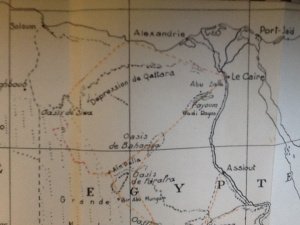
Almasy wrote his own book about his travels - Récentes Explorations dans Le Désert Libyque (1932 - 1936) - which, as you can tell from the title, was written in French. This is bad news for me as it means I can’t read it. However, after finding the book in the library I thought I would share here some pictures that I took of it.
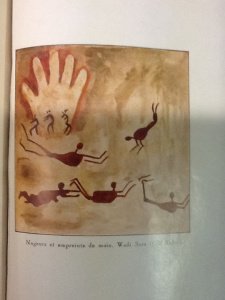 The above watercolour must be one of the most famous images to come out of the Gilf Kebir (Wadi Sura). As you can see, it shows men swimming. Once upon a time the desert was a fertile land.
The above watercolour must be one of the most famous images to come out of the Gilf Kebir (Wadi Sura). As you can see, it shows men swimming. Once upon a time the desert was a fertile land.
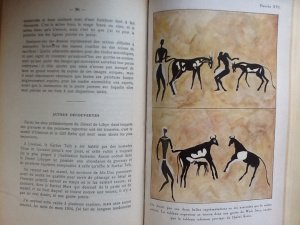 If you have heard of Laszlo Almásy these days you are either an Egyptologist or, like me, a fan of The English Patient film and/or book. Both, however, are inspired rather than based on his life. The real Almásy did not have an affair with a woman named Katherine Clifton; neither did he bring about her death or that of her husband, Geoffrey. In fact, the Cliftons were based on a young couple named Sir Robert and Dorothy Clayton-East-Clayton. Sir Robert accompanied Almásy into the desert in April 1932 but, sadly, died of an illness picked up there in September of the same year. As for Dorothy, not only did she not sleep with Almásy but appears to have actively disliked him. More could be said about that, but not here. For the remainder of this post, I would like to share with you Sir Robert Clayton-East-Clayton’s report on his trip into the desert. It was published by The Times newspaper on 6th July 1932.
If you have heard of Laszlo Almásy these days you are either an Egyptologist or, like me, a fan of The English Patient film and/or book. Both, however, are inspired rather than based on his life. The real Almásy did not have an affair with a woman named Katherine Clifton; neither did he bring about her death or that of her husband, Geoffrey. In fact, the Cliftons were based on a young couple named Sir Robert and Dorothy Clayton-East-Clayton. Sir Robert accompanied Almásy into the desert in April 1932 but, sadly, died of an illness picked up there in September of the same year. As for Dorothy, not only did she not sleep with Almásy but appears to have actively disliked him. More could be said about that, but not here. For the remainder of this post, I would like to share with you Sir Robert Clayton-East-Clayton’s report on his trip into the desert. It was published by The Times newspaper on 6th July 1932.
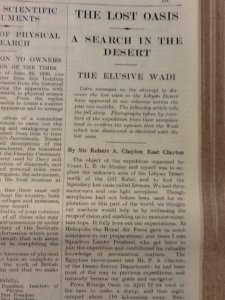
***
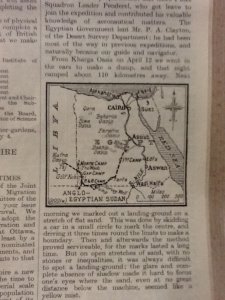
***
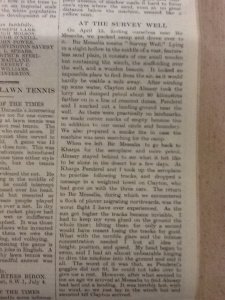
***
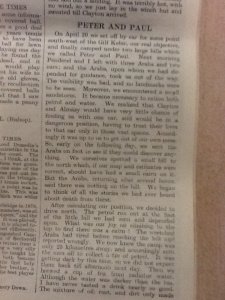
***
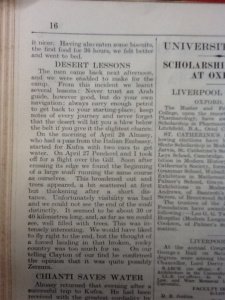
***
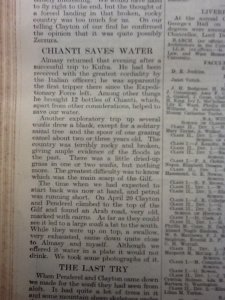
***
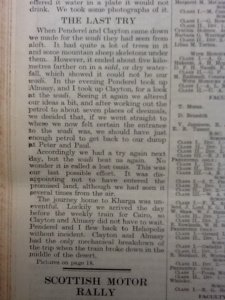
The report reads:
THE LOST OASIS
A SEARCH IN THE DESERT
THE ELUSIVE WADI
Cairo messages on the attempt to discover the lost oasis in the Libyan Desert have appeared in our columns within the last two months. The following article tells the full story. Photographs by members of the expedition from their aeroplane tend to confirm the opinion that the Wadi which was discovered is identical with the lost oasis.
By Sir Robert A. Clayton East Clayton
The object of the expedition organized by Count L. E. de Almasy and myself was to explore the unknown area of the Libyan Desert north of the Gilf Kebir, and to find the legendary lost oasis called Zerzura. We had three motor-cars and one light aeroplane. Though aeroplanes had not before been used for exploration in this part of the world, we thought our machine would help us by increasing the range of vision and enabling us to examine mountain-tops. It fully bore out our expectations. At Heliopolis the Royal Air Force gave us much assistance in our preparations; and there I met Squadron Leader Penderel, who got leave to join the expedition and contributed his valuable knowledge of aeronautical matters. The Egyptian Government lent Mr. P. A. Clayton, of the Desert Survey Department; he had been most of the way in previous expeditions, and naturally became our guide and navigator.
…..From Kharga Oasis on April 12 we went in the cars to make a dump, and that night camped about 110 kilometres away. Next morning we marked out a landing-ground on a stretch of flat sand. This was done by skidding a car in a small circle to mark the centre, and driving it three times round the limits to make a boundary. Then and afterwards the method proved serviceable, for the marks lasted for a long time. But on open stretches of sand, with no stones or inequalities, it was always difficult to spot a landing-ground; the glare and complete absence of shadow made it hard to focus one’s eyes where the sand, even at no great distance below the machine, seemed like a yellow mist.
.
AT THE SURVEY WELL
On April 15, finding ourselves near Bir Messalia, we packed camp and drove over to it. Bir Messalia means “Survey Well.” Lying in a slight hollow in the middle of a vast, featureless sand plain, it consists of one small wooden hut containing the winch, the scaffolding over the well and a wooden beacon. It looked an impossible place to find from the air, as it would hardly be visible a mile away. After winding up some water, Clayton and Almasy took the lorry and dumped petrol about 80 kilometres further on in a line of crescent dunes. Penderel and I marked out a landing-ground near the well. As there were practically no landmarks, we made corner marks of empty benzine tins in addition to our usual circle and boundary. We also prepared a smoke fire in case the machine was seen searching for the camp.
…..When we left Bir Messalia to go back to Kharga for the aeroplane and more petrol, Almasy stayed behind to see what it felt like to be alone in the desert for a few days. At Kharga Penderel and I took up the aeroplane to practice following tracks, and dropped a message in a weighted towel on Clayton, who had gone on with the three cars. The return to Bir Messalia, during which we encountered a flock of plover migrating northwards, was the worst flight I have ever experienced. As the sun got higher the tracks became invisible. I had to keep my eyes glued on the ground the whole time; lifting them for only a second would have meant losing the tracks for good. What with the terrible glare and the intense concentration needed I lost all idea of height, position, and speed. My head began to swim, and I had an almost unbearable longing to dive the machine into the ground and end it all. The worst of it all was that, as Penderel’s goggles did not fit, he could not take over to give me a rest. However, after what seemed to me an age we arrived at Messalia to find Almasy had laid out a landing. It was terribly hot, with no wind, so we just lay in the winch hut and sweated till Clayton arrived.
.
PETER AND PAUL
On April 20 we set off by car for some point south-west of the Gilf Kebir, our real objective, and finally camped under two large hills which we called Peter and Paul. Next morning Penderel and I left with three Arabs and two cars; and the Arabs, upon whom we had depended for guidance, took us out of the way. The visibility was bad, and no landmarks were to be seen. Moreover, we encountered a small sandstorm. It became necessary to ration both petrol and water. We realized that Clayton and Almasy would have very little chance of finding us with one car, and would be in a dangerous position, having to trust their lives to that car in those vast spaces. Accordingly it was up to us to get out of our own mess. So, early on the following day, we sent the Arabs on foot to see if they could discover anything. We ourselves spotted a small hill to the north which, if our map and estimates were correct, should have had a small cairn of it. But the Arabs, returning after several hours, said there was nothing on the hill. We began to think of all the stories we had ever heard about death from thirst.
…..After calculating our position, we decided to drive north. The petrol ran out at the foot of the little hill we had seen and depended upon. What was our joy on climbing to the top to find that there was a cairn! The wretched Arabs had tired before reaching the hill and reported wrongly. We now knew the camp was only 25 kilometres away, and accordingly sent the men off to collect a tin of petrol. It was getting dark by this time, so we did not expect them back till afternoon next day. Then we brewed a cup of tea from radiator water. Although the water was darker than the tea, I have never tasted a drink nearly so good. The mixture of oil, rust, and dirt only made it nicer. Having also eaten some biscuits, the first food for 36 hours, we felt better and went to bed.
.
DESERT LESSONS
The men came back next afternoon, and we were enabled to make for the camp. From this incident we learnt several lessons: Never trust an Arab guide, however good, but do your own navigation; always carry enough petrol to get back to your starting-place; keep notes of every journey and never forget that the desert will hit you a blow below the belt if you give it the slightest chance.
…..On the morning of April 26 Almasy, who had a pass from the Italian embassy, started for Kufra with two cars to get water. On April 27 Penderel and I took off for a flight over the Gilf. Soon after crossing its edge we found the beginning of a large wadi running the same course as ourselves. This broadened out and trees appeared, a bit scattered at first but thickening after a short distance. Unfortunately visibility was bad and we could not see the end of the wadi distinctly. It seemed to be about 30 or 40 kilometres long, and, as far as we could see, well filled with trees. This was intensely interesting. We would have liked to fly right to the end, but the thought of a forced landing in that broken, rocky country was too much for us. On our telling Clayton of our find he confirmed the opinion that it was quite possibly Zerzura.
.
CHIANTI SAVES WATER
Almasy returned that evening after a successful trip to Kufra. He had been received with the greatest cordiality by the Italian officers; he was apparently the first tripper there since the Expeditionary Force left. Among other things he brought 12 bottles of Chianti, which, apart from other considerations, helped to save our water.
…..Another exploratory trip up several wadis drew a blank, except for a solitary saizal tree and the spoor of one grazing camel about two or three years old. The country was terribly rocky and broken, giving ample evidence of the floods in the past. There was a little dried-up grass in one or two wadis, but nothing more. The greatest difficulty was to know which was the main scarp of the Gilf.
…..The time when we had expected to start back was now at hand, and petrol was running short. On April 20 Clayton and Penderel climbed to the top of the Gilf and found an Arab road, very old, marked with cairns. As far as they could see it led to a large wadi a bit to the south. While they were up on top, a swallow, very exhausted, came down quite close to Almasy and myself. Although we offered it water in a plate it would not drink. We took some photographs of it.
.
THE LAST TRY
When Penderel and Clayton came down we made for the wadi they had seen from aloft. It had quite a lot of trees in it and some mountain sheep skeletons under them. However, it ended about five kilometres further on in a sidd, or dry waterfall, which showed it could not be our wadi. In the evening Penderel took up Almasy, and I took up Clayton, for a look at the wadi. Seeing it again we altered our ideas a bit, and after working out the petrol to about seven places of decimals, we decided that, if we went straight to where we now felt certain the entrance to the wadi was, we should have just enough petrol to get back to our dump at Peter and Paul.
…..Accordingly we had a try again next day, but the wadi beat us again. No wonder it is called a lost oasis. This was our last possible effort. It was disappointing not to have entered the promised land, although we had seen it several times from the air.
…..The journey home to Kharga was uneventful. Luckily we arrived the day before the weekly train for Cairo, so Clayton and Almasy did not have to wait. Penderel and I flew back to Heliopolis without incident. Clayton and Almasy had the only mechanical breakdown of the trip when the train broke down in the middle of the desert.
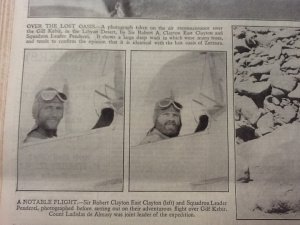
Like this:
Like Loading...
